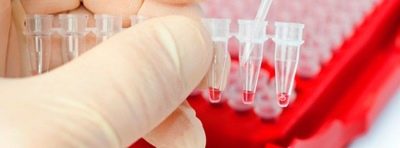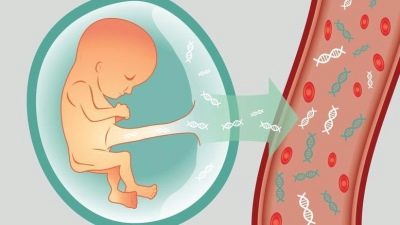Why do a DOT test during pregnancy and what are the reviews about it?
Any pregnant woman wants to be sure that her baby is completely healthy. Especially strongly need such confidence women who have reason to doubt it. One can find out the truth by agreeing to amniocentesis, chorionic biopsy, and cordocentesis. However, these procedures can be dangerous to the life of the child. Today there is a safer alternative - the DOT test.
What it is?
The DOT test is a non-invasive method of prenatal DNA diagnosis. It is designed to determine the sex of the child, as well as possible pathologies of a chromosomal sense, such as Down syndrome and a number of other anomalies. For the study used blood taken from the veins of a pregnant woman. There are no punctures of the fetal bladder and the associated risks of losing your baby.
The essence of the method is based on understanding the processes that occur in the body of the future mother during pregnancy. Thus, due to the natural death of some cells of the placenta, a part of the blood cells of the fetus enters the mother’s blood. By the 10th week of pregnancy, the amount of such free-circulating extracellular DNA of a baby in maternal blood approaches 10% of the total amount of mother's blood.
From this date you can do the DOT test. In a sample of blood taken from a woman's vein, fetal DNA is isolated. His research provides a detailed answer to the question of whether the baby is healthy. The test shows whether pathologies such as are present in the crumbs of my mother's womb:
- Down syndrome;
- Edwards syndrome;
- patau syndrome;
- Clintfelter syndrome;
- Turner syndrome.
All of these anomalies are considered total, and often lethal for the little one, because they are not compatible with life. The exception is Down syndrome: “sunny” babies are viable. But not every family is ready to accept and raise such a child. That is why there is a need for the DOT test.
Is the analysis accurate?
The truth of the DOT test is quite high. So, Edwards, Patau and Down syndromes he defines almost unmistakably: by 99.7%. Turner and Klinefelter syndromes - with a probability of up to 90%. The sex of the child is determined already at 10-11 weeks with a probability higher than 99%. The blood type and Rh factor of the baby is determined with the same accuracy, which makes it possible to assess the risks of developing Rh-conflict if the woman has Rh-negative blood.
The error is excluded if the material for the study is collected correctly and the study itself was conducted in accordance with all strict criteria.
Indications
The test can be carried out to any woman she wishes. Mandatory condition - singleton pregnancy. If a woman bears a twin or a triple, in this case it is impossible to vouch for the accuracy of the results of DNA research. But this is general information, and direct indications for the DOT test are:
- the age of the mother is over 35 years old (the probability of chromosomal abnormalities increases with age);
- increased or high risks as a result of general screenings, which are conducted by pregnant women in the first and second trimester of pregnancy;
- the probability of producing an unhealthy child due to unfavorable heredity, if there were already cases of the birth of such babies in the family;
- miscarriages or missed abortion in history;
- closely related marriage or pregnancy resulting from incest.
The test can be carried out during pregnancy, which has come with the help of assisted reproductive technology (IVF), as well as during surrogate motherhood.
Contraindications
The test is not carried out if more than one fetus grows in a woman’s womb, as well as with accompanying oncological diseases of the expectant mother. Also, the test will not give a reliable result if in the past six months the expectant mother has received a blood transfusion.
How is the test performed?
DOT test is carried out in three simple steps. On the appointed day, a woman needs to come to the clinic and take a routine blood test. Next, the baby’s DNA is extracted from it by the method of genomic sequencing. The final stage is the decoding of data and the design of the probability of risk for each of the identified chromosomal diseases. It is this conclusion and issue a pregnant woman.
How long does the study take?
As with all non-invasive prenatal tests (NIPT), the DOT test is not done quickly. It usually takes 10 to 12 days to get results. In some cases, professionals may need a little more time. It all depends on the workload of the laboratory and the order of research in this medical institution.
Sometimes during the allotted time, specialists can not isolate the fetal DNA. The woman is asked to donate blood for a new study.
Advantages and disadvantages
The undoubted advantage of the DOT test is that the result can be obtained much earlier than with other diagnostic methods. If you do the test at the 11th week of pregnancy, then in ten days the result will be known. The first screening, for comparison, is conducted only between 11 and 13 weeks, and its results will also have to wait. In addition, the accuracy of the DOT test is incomparably higher, because screening diagnostics is the most common calculation of probability and nothing more.
Early notification leaves the pregnant woman with a choice: you can have time to terminate the pregnancy if she makes such a decision (you can do this yourself up to twelve weeks of pregnancy). If the test is done at a later date, then the woman will have to get confirmation of the result from non-invasive diagnosis by passing invasive, because such tests are not yet grounds for doctors to issue a referral to abortion for medical reasons.
To obtain such a direction, you still need to do a chorion biopsy or amniocentesis. This is the relative minus of the method.
On the other hand, the woman has no doubt. If the DOT test showed Down syndrome in a child and a woman does not want to give birth to such a baby, then she will go for an invasive diagnosis without any extra fear. The accuracy of the test is high, but a negative DOT test means that there is no need for invasive diagnostics., baby is all right, even if the results of the screening study were disappointing. The results of the DOT test are difficult to interpret in two ways or ambiguously. The conclusion indicates the name of the disease and the actual risk of its presence as a percentage. Normally, the results should be negative, and the risks - low.
To force a woman to terminate a pregnancy, if the child is sick, no one has the right. She may decide to leave the baby, and then the doctors will continue to carry out the pregnancy, provide all the necessary medical and consultative support.
Another noticeable disadvantage of the DOT test is that so far such a diagnosis is poorly distributed. Such analyzes are carried out only in the medical genetic centers, specialized clinics. These are not in every small town, but because a woman will have to find the nearest clinic and go for testing just there.
The number of diseases determined by the DOT test is significantly lower than the number of pathologies that can be detected during the passage of invasive diagnosis.Therefore, in the contract with the clinic, a woman will surely be shown a clause stating that good results do not guarantee the birth of a healthy child.
How much is it?
In different regions of Russia, the price may vary. It all depends on the medical institution. The average cost of the DOT test as of the beginning of 2018 is 29 thousand rubles. The most affordable prices are offered by the network clinics Genoanalitika and UltraMed.
Pregnant Reviews
Despite the fact that the test has been used in Russia for about 5 years, many women during pregnancy have no idea about this diagnostic method. This is due to the lack of reliable and detailed information, because the doctors are not in a hurry to talk about the new product primarily because they may be suspected of imposing paid medical services. Another reason for the obstetrician-gynecologists to be silent is the need to carry out an invasive diagnosis anyway, if the child has a pathology.
For these reasons, the number of reviews about the DOT test is very, very small. However, the available reviews provide an opportunity to judge that the research is really accurate, although quite expensive. The women who found the information, the means, and did such a test, were very pleased: whatever the truth, it is better than ignorance.
About the possibilities of the DOT test during pregnancy, see the following video.




















